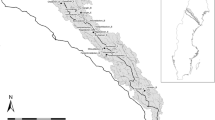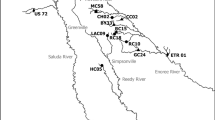Abstract
The potentials for the use of large wood (LW) in stream restoration projects were quantified for streams in Central Europe (total stream length assessed 44,880 km). Two different restoration methods were investigated: recruitment (passively allowing natural LW input) and placement (active introduction of large wood pieces into streams). The feasibility and potential effects of each method were studied for three different scenarios, according to the land-uses to be permitted on the floodplain: (a) only natural-non woody vegetation, forest, and fallow land occur on the floodplain, (b) including pasture and meadow, (c) including pasture, meadow, and cropland. Hydromorphological data were used to identify stream sections where LW recruitment or placement are feasible, and the likely effects of both restoration methods on channel hydromorphology were predicted. Passive recruitment is feasible for only a small percentage of the total channel length in the study area (~1% for all three scenarios). Active placement of LW can be used in much higher extent: 6.5% if only natural non-woody vegetation, forest, and fallow land can occur on the floodplain, 20.2% if stream segments bordered by pasture and meadow are included, and 32% if cropland is included in addition. There are differences between (1) the lower-mountainous area, where a large number of channel segments can be restored yielding an improvement from a moderate/good to a good/excellent morphological status and (2) the lowlands, where only a small number of channel segments can be restored yielding an improvement from a bad to a moderate morphological state. The latter upgrading might be sufficient to reach a ‘good ecological status’ as defined by the EU Water Framework Directive. The results of this study show the suitability of large wood recruitment and placement as appropriate methods to markedly improve the hydromorphological state of a large proportion of the streams in the study area.
Similar content being viewed by others
References
A.C. Benke J.B. Wallace (2003) Influence of wood on invertebrate communities in streams and rivers S. Gregory K.L. Boyer A.M. Gurnell (Eds) The Ecology and Management of Wood in World Rivers American Fisheries Society, Symposium 37 BethesdaMaryland 149–177
R.E. Bilby (1981) ArticleTitleRole of organic debris dams in regulating the export of dissolved and particulate matter from a forested watershed Ecology 62 1234–1241
D.C. Bragg J.L. Kershner D.W. Roberts (2000) Modeling large woody debris recruitment for small streams of the central Rocky Mountains United States Department of AgricultureRocky Mountains Research Station Fort Collins, ColoradoUSA
E. Briem (2003) Gewässerlandschaften der Bundesrepublik Deutschland – Morphologische Merkmale der Fließgewässer und ihrer Auen ATV-DVWK-Arbeitsbericht GB-1 Hennef, Germany 176
A. Brookes (1987) ArticleTitleThe distribution and management of channelized streams in Denmark Regul. Rivers Res. Manag. 18 3–16
A.P. Brooks P.C. Gehrke J.D. Jansen T.B. Abbe (2004) ArticleTitleExperimental reintroduction of woody debris on the Williams RiverNSW: Geomorphic and ecological responses River Res. Appl. 20 513–536 Occurrence Handle10.1002/rra.764
M. Brunke A. Hoffmann M. Pusch (2001) ArticleTitleUse of mesohabitat-specific relationships between flow velocity and river discharge to assess invertebrate minimum flow requirements Regul. Rivers Res. Manag. 17 667–676 Occurrence Handle10.1002/rrr.626
A. Buffagni J.L. Kemp S. Erba C. Belfiore D. Hering Moogo (2001) ArticleTitleA Europe-wide system for assessing the quality of rivers using macroinvertebrates: the AQEM project and its importance for southern Europe (with special emphasis on Italy) J. Limnol. 60 39–48
C.J. Cederholm R.E. Bilby P.A. Bisson T.W. Bumstead B.R. Fransen W.J. Scarlett J.W. Ward (1997) ArticleTitleResponse of juvenile coho salmon and steelhead to placement of large wood in a coastal Washington stream N. Am. J. Fish. Manag. 17 947–963 Occurrence Handle10.1577/1548-8675(1997)017<0947:ROJCSA>2.3.CO;2
B.D. Collins D.R. Montgomery (2002) ArticleTitleForest developmentwood jams, and restoration of floodplain rivers in the Pudget LowlandWashington Restor. Ecol. 10 237–247 Occurrence Handle10.1046/j.1526-100X.2002.01023.x
V. Crispin R. House D. Roberts (1993) ArticleTitleChanges in instream habitatlarge woodand salmon habitat after the restructuring of a coastal Oregon stream N. Am. J. Fish. Manag. 13 96–102 Occurrence Handle10.1577/1548-8675(1993)013<0096:CIIHLW>2.3.CO;2
D.A. Crook A.I. Robertson (1999) ArticleTitleRelationship between riverine fish and woody debris: implications for lowland rivers Mar. Freshwater Res. 50 941–953 Occurrence Handle10.1071/MF99072
C.A. Dolloff M.L. Warren (2003) Fish relationship with large wood in small streams S. Gregory K.L. Boyer A.M. Gurnell (Eds) The Ecology and Management of Wood in World Rivers American Fisheries Society, Symposium 37 BethesdaMaryland 179–193
T. Dudley N.H. Anderson (1982) ArticleTitleA survey of invertebrates associated with wood debris in aquatic habitats Melanderia 39 1–21
T.P. Ehrman G.A. Lamberti (1992) ArticleTitleHydraulic and particulate matter retention in a 3rd-order Indiana stream J. N. Am. Benthol. Soc. 11 341–349
H. Ellenberg (1996) Vegetation Mitteleuropas mit den Alpen Ulmer StuttgartGermany 1095
L.S. Fore J.R. Karr R.W. Wisseman (1996) ArticleTitleAssessing invertebrate responses to human activities: Evaluating alternative approaches J. N. Am. Benthol. Soc. 15 212–231
M. Gerhard M. Reich (2001) Totholz in Fließgewässern – Empfehlungen zur Gewässerentwicklung Werum GmbH Mainz, Germany 84
C.J. Gippel I.C. O’Neill B.L. Finlayson I. Schnatz (1996) ArticleTitleHydraulic guidelines for the re-introduction and management of large wood in lowland rivers Regul. Rivers Res. Manag. 12 223–236 Occurrence Handle10.1002/(SICI)1099-1646(199603)12:2/3<223::AID-RRR391>3.3.CO;2-R
S.V. Gregory K.L. Boyer A.M. Gurnell (Eds) (2003a) The Ecology and Management of Wood in World Rivers American Fisheries Society, Symposium 37 BethesdaMaryland 431
S.V. Gregory M.A. Meleason D.J. Sobota (2003b) Modeling the dynamics of wood in streams and rivers S. Gregory K.L. Boyer A.M. Gurnell (Eds) The Ecology and Management of Wood in World Rivers American Fisheries Society, Symposium 37 BethesdaMaryland 315–335
A.M. Gurnell (2003) Wood storage and mobility S. Gregory K.L. Boyer A.M. Gurnell (Eds) The Ecology and Management of Wood in World Rivers American Fisheries Society, Symposium 37 BethesdaMaryland 75–91
A.M. Gurnell K.J. Gregory G.E. Petts (1995) ArticleTitleCase studies and reviews: The role of coarse woody debris in forest aquatic habitats: implications for management Aqua. Conser. Marine Freshwater Ecosys. 5 143–166
M.E. Harmon J.F. Franklin F.J. Swanson P. Sollins S.V. Gregory J.D. Lattin N.H. Anderson S.P. Cline N.G. Aumen J.R. Sedell G.W. Lienkaemper K. Cromack K.W. Cummins (1986) ArticleTitleEcology of coarse woody debris in temperate ecosystems Adv. Ecol. Res. 15 133–302
D. Hering J. Kail S. Eckert M. Gerhard E.I. Meyer M. Mutz M. Reich I. Weiss (2000) ArticleTitleCoarse woody debris quantity and distribution in Central European streams Intl. Rev. Hydrobiol. 85 5–23 Occurrence Handle10.1002/(SICI)1522-2632(200003)85:1<5::AID-IROH5>3.3.CO;2-O
D. Hering O. Moog L. Sandin P.F.M. Verdonschot (2004) ArticleTitleOverview and application of the AQEM assessment system Hydrobiologia 516 1–20 Occurrence Handle10.1023/B:HYDR.0000025255.70009.a5
R.H. Hilderbrand A.D. Lemly C.A. Dolloff K.H. Harpster (1998) ArticleTitleDesign considerations for large wood placement in stream enhancement projects N. Am. J. Fish. Manag. 18 161–167 Occurrence Handle10.1577/1548-8675(1998)018<0161:DCFLWD>2.0.CO;2
A. Hoffmann D. Hering (2000) ArticleTitleWood-associated macroinvertebrate fauna in Central European streams Intl. Rev. Hydrobiol. 85 25–48 Occurrence Handle10.1002/(SICI)1522-2632(200003)85:1<25::AID-IROH25>3.3.CO;2-I
J. Illies (1978) Limnofauna Europaea Gustav Fischer Verlag StuttgartGermany 532
J. Kail (2003) ArticleTitleInfluence of large wood on the morphology of six Central European streams Geomorphology 51 207–223 Occurrence Handle10.1016/S0169-555X(02)00337-9
J. Kail (2004) Geomorphic effects of large wood in streams and rivers and its use in stream restoration: a Central European perspective. Ph.D. Thesis Universität Duisburg-Essen Essen, Germany 153
G.M. Kondolf (2000) ArticleTitleSome suggested guidelines for geomorphic aspects of anadromous salmonid habitat restoration proposals Restor. Ecol. 8 48–56 Occurrence Handle10.1046/j.1526-100x.2000.80007.x
Lassettre N. and Kondolf G.M. 2000. Process-based management of in-channel large woody material at the basin scale. In: Proceedings of the International Conference on Wood in World Rivers at the Oregon State University. Corvallis, Oregon, USApp. 38–38, October 2000.
A. Lorenz D. Hering C. Feld P. Rolauffs (2004) ArticleTitleA new method for assessing the impact of morphological degradation on the benthic invertebrate fauna for streams in Germany Hydrobiologia 516 107–127 Occurrence Handle10.1023/B:HYDR.0000025261.79761.b3
R. Marchant G. Hehir (2002) ArticleTitleThe use of AUSRIVAS predictive models to assess the response of lotic macroinvertebrates to dams in south-east Australia Freshwater Biol. 47 1033–1050 Occurrence Handle10.1046/j.1365-2427.2002.00823.x
C. Maser J.R. Sedell (1994) From the Forest to the Sea – The Ecology of Wood in Streams, Rivers, Estuaries, and Oceans St. Lucie Press Delray BeachUSA 196
T.E. McMahon G.F. Hartman (1989) ArticleTitleInfluence of cover complexity and current velocity on winter habitat use by juvenil Coho Salmon (Oncorynchus kisutch) Can. J. Fish. Aqua. Sci. 46 1551–1557
C.A. Mebane (1999) ArticleTitleTesting bioassessment metrics: Macroinvertebratesculpin and salmonid responses to stream habitatsediment and metals Environ. Monitor. Assess. 67 293–322 Occurrence Handle10.1023/A:1006306013724
M.L. Murphy K.V. Koski (1989) ArticleTitleInput and depletion of woody debris in Alaska streams and implications for streamside management N. Am. J. Fish. Manag. 9 427–436 Occurrence Handle10.1577/1548-8675(1989)009<0427:IADOWD>2.3.CO;2
M. Mutz (2000) ArticleTitleInfluences of woody debris on flow patterns and channel morphology in a low energy, sand-bed stream reach Intl. Rev. Hydrobiol. 85 107–121 Occurrence Handle10.1002/(SICI)1522-2632(200003)85:1<107::AID-IROH107>3.3.CO;2-C
H. Piégay A.M. Gurnell (1997) ArticleTitleLarge wood and river geomorphological patter: examples from S.E. France and S. England Geomorphology 19 99–116 Occurrence Handle10.1016/S0169-555X(96)00045-1
T. Pottgiesser M. Sommerhäuser (2004) Fließgewässertypologie Deutschlands: Die Gewässertypen und ihre Steckbriefe als Beitrag zur Umsetzung der EU-Wasserrahmenrichtlinie C. Steinberg W. Calmano R. Wilken H. Klapper (Eds) Handbuch Angewandte Limnologie Ecomed Landsberg, Germany 3–16
C.F. Rabeni R.B. Jacobson (1993) ArticleTitleThe importance of fluvial hydraulics to fish-habitat restoration in low-gradient alluvial streams Freshwater Biol. 29 211–220
P.J. Raven N.T.H. Homes P. Charrier F.H. Dawson M. Naura P.J. Boon (2002) ArticleTitleTowards a harmonized approach for hydromorphological assessment of rivers in Europe: a qualitative comparison of three survey methods Aqua. Conser. Marine Freshwater Ecosys. 12 405–424 Occurrence Handle10.1002/aqc.536
Rolauffs P. 2003. Ökologische Bewertung von Fließgewässern: Integrierende Einflüsse des Einzugsgebietes oder lokale Gewässermorphologie? Was ist entscheidend für die Biozönose? Eine Frage der Skalierung. In: Tagungsbericht Deutsche Gesellschaft für Limnologie (DGL). Braunschweig, Germany, 2002, pp. 98–103.
P. Roni T.J. Beechie R.E. Bilby F.E. Leonetti M.M. Pollock G.R. Pess (2002) ArticleTitleA review of stream restoration techniques and a hierarchical method for prioritizing restoration in Pacific Northwest watersheds N. Am. J. Fish. Manag. 22 1–20 Occurrence Handle10.1577/1548-8675(2002)022<0001:AROSRT>2.0.CO;2
Schmedtje U., Sommerhäuser M., Braukmann U., Briem E., Haase P. and Hering D. 2001. `Top down–bottom up’-Konzept einer biozönotisch begründeten Fließgewässertypologie Deutschlands. In: Tagungsbericht Deutsche Gesellschaft für Limnologie (DGL). Magdeburg, Germany, 2000, pp. 147–151.
L.A. Smock G.M. Metzler J.E. Gladden (1989) ArticleTitleRole of debris dams in the structure and functioning of low-gradient headwater streams Ecology 70 764–775
R. Smukalla G. Friedrich (1994) Ökologische Effizienz von Renaturierungsmaßnahmen an Fließgewässern N.R.W. Landesumweltamt (Eds) Materialien 7 Essen Germany 462
R.A. Sponseller E.F. Benfield H.M. Valett (2001) ArticleTitleRelationships between land-usespatial scale and stream macroinvertebrate communities Freshwater Biol. 46 1409–1424 Occurrence Handle10.1046/j.1365-2427.2001.00758.x
P.F.M. Verdonschot R.C. Nijboer (2004) ArticleTitleTowards a decision support system for stream restoration in the Netherlands: an overview of restoration projects and future needs Hydrobiologia 478 131–148 Occurrence Handle10.1023/A:1021026630384
B.M. Weigel L.Z. Wang P.W. Rasmussen J.T. Butcher P.M. Stewart T.P. Simon M.J. Wiley (2003) ArticleTitleRelative influence of variables at multiple spatial scales on stream macroinvertebrates in the Northern Lakes and forest ecoregion, USA Freshwater Biol. 48 1440–1461 Occurrence Handle10.1046/j.1365-2427.2003.01076.x
Author information
Authors and Affiliations
Corresponding author
Rights and permissions
About this article
Cite this article
Kail, J., Hering, D. Using Large Wood to Restore Streams in Central Europe: Potential use and Likely Effects. Landscape Ecol 20, 755–772 (2005). https://doi.org/10.1007/s10980-005-1437-6
Received:
Accepted:
Issue Date:
DOI: https://doi.org/10.1007/s10980-005-1437-6




